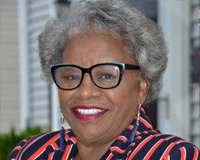Senators Moore, McCrory, Winfield Call for Increased Funding for Violence Prevention Programs to Address Shootings in Cities
The Hartford, Bridgeport, and New Haven Legislators Call for More Resources Follows the Shooting and Death of a 3-Year-Old in Hartford
In response to the tragic death of a 3-year-old boy and 16-year-old teenager from separate shootings in Hartford this past weekend, State Senator Marilyn Moore (D-Bridgeport) and State Senator Doug McCrory (D-Hartford) are calling on Governor Lamont to increase funding to statewide violence prevention programs to bolster efforts to prevent future shootings that leave families and neighborhoods grieving.
“I am tired of the senseless taking of lives lost of loved ones to gun violence. The problem of gun violence impacts every community and it is imperative we take this problem on by creating a master plan and dedicate funding to support it. We need to more funding now for programs that will stop future tragedies and create needed changes to address the senseless gun violence that plagues Bridgeport and urban communities across our state,” said Sen. Moore. Gun violence intervention programs across the state must build a coalition, develop a five year plan funded by the State and supplemented with American Rescue Act dollars. “We have to do more in protecting the health and safety of families, friends, and the community at-large. We know what programs work and it is time that we fund these initiatives and put our money where our mouth is.”
“How many more mothers, families, have to mourn the loss of a child. We need to act, and we must increase resources for violence prevention initiatives and programs to keep our kids safe and stop more deaths from happening,” said Sen. McCrory. “Shootings and gun violence cause more than just injury and death, but also leave lasting trauma on survivors, family members and neighborhoods, particularly on kids and teenagers who become more likely to face mental health issues or their academic performance suffers because of exposure to such violence.”
“Children should never experience being unable to see their brother or sister again. No parent should understand what it means to bury their child,” said Sen. Winfield. “Gun violence has scarred far too many neighborhoods. It has to come to end now, not later. I am urging the allocation of more funding to intervention programs dedicated to stopping future deaths. We have put money into these programs for the safety of our children. If we do not, then it is their lives and neighborhoods that will suffer.”
While youth violence programs have received some funding in recent years. From Fiscal Year 2019 to 2021, Hartford received $350,000 in state funding to address youth gun violence through various initiatives, Bridgeport received $375,000, New Haven received $375,000, Meriden received $140,000, Waterbury received $361,800, and West Haven received $140,000. The ARA under President Biden is calling on Congress to include $5 billion over eight years in support of evidence-based community violence prevention programs. He is calling on Congress to invest in job training for formerly incarcerated individuals and justice-involved youth and in improving public safety. Combined, these funds are an opportunity to create, implement, and evaluate a plan to build statewide coalitions for cities most impacted by gun violence.
The shooting in Hartford last weekend follows an increase in shootings and gun violence in 2020 in Hartford, Bridgeport, and New Haven. The Hartford Police Department reported in fall 2020 that they had a 54% increase in shootings incidents from last year. Bridgeport experienced a substantial increase in shootings in 2020 as well. The city saw a 30 percent increase in shootings in 2020 compared to 2019. New Haven reported 274 incidents of shots being fired, which was up from 151 in 2019.
Gun violence carries a disproportionate impact on communities of color, especially on Black men. Statistics from to the Giffords Law Center to Prevent Gun Violence said that over 50 percent of Connecticut’s gun homicide victims were Black men though they are less than 6 percent of the state’s population. According to the same report, Black men between 18 to 35 years old were close to 39 times more likely to be murdered with a gun compared to white men in the state.
Further underscoring the need to build up resources for violence prevention programs, young people also make up a substantial portion of victims of gun violence. A 2020 news report found that around 10 percent of individuals murdered by guns in Connecticut’s three largest cities between 2010 and mid-2020 were 25 years old or younger.
These devastating acts of violence leave families grieving, but also young people witnessing such acts can be left with harm to their mental and physical health. According to Everytown for Gun Safety, children exposed to violence, crime, and abuse are more likely to suffer from depression and PTSD; and children living in neighborhoods where gun violence is a recurring feature can lead to them spending less time being physically active. Additionally, a study cited by Everytown found that high school students who experience violence have lower rates of graduation.
Share this page:
